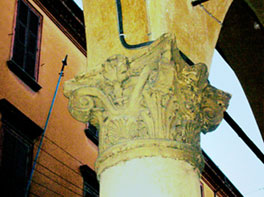|
BED AND BREAKFAST IN BOLOGNA ACCOMMODATION IN BOLOGNA ERBORISTERIA WEBMASTER |
||||||
|
|
The 14th Century Bolognese painting, disregarded for
centuries, matched the greatness of the most famous Tuscan 14th Century
painting. It was Roberto Longhi who recently discovered the
14th Century Bolognese painting and defined it as "brutally sincere and
impulsive" but with a fairy tale element incorporating earthy, peasant and
regional quality and the northern influence. Besides the extensive collection of the National Picture Gallery, 14th Century Bolognese paintings can also be found in many "church-galleries" in town.
Towards the end of the 14th
Century the "Legato Pontificio" was replaced by the government of the "XVI
Riformatori dello Stato di Liberta " , which proposed a vast programme of
public intervention. The architect appointed,
Antonio di Vincenzo, introduced the international Gothic style to the
city. |
|
b u |
|||
|
General - Environment - Iron and Etruscan Age - Roman Age - Patron Saint- The Commune - Alma mater studiorum - Re Enzo - Porticoes - St Peter - Gothic - 14th Century - Piazza Maggiore - Aristocratic palaces - Brick and other stones - Early 15th Century - Archiginnasio - Counter Reformation Renaissance - 16th Century - Great portico ribbons - Frescoes in palaces - The "scenographic" city - Napoleon's republics - Fall of Church power - The Restoration - Haussmann style - The new Century - Floreal style - Rationalism - World War - Active preservation - Around 2000 |
||||||
